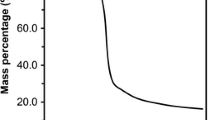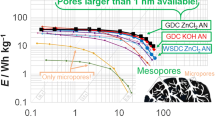Abstract
Almond shell-based chemically treated and activated nanoporous charcoal powder (AS(T)) has been successfully prepared by chemical activation method using potassium hydroxide (KOH) as an activating agent. The as-synthesized AS(T) was systematically characterized by various techniques like N2 adsorption, scanning electron microscopy (SEM), X-ray diffraction, and thermogravimetric analysis. The AS(T)-based nanoporous activated charcoal is tested as an electrode material with ionic liquid-based polymer gel electrolyte for electrochemical double-layer capacitors (EDLCs). EDLCs prepared from AS(T) exhibit specific capacitance of 986.3 mF cm−2 (equivalent to single-electrode specific capacitance of 563.6 F g−1). The energy density of 62.8 Wh kg−1 and power density of 2.1 kW kg−1 have been observed for nanoporous AS(T)-based EDLCs.









Similar content being viewed by others
References
Conway BE (1999) Electrochemical supercapacitors: scientific fundamentals and technical applications. Kluwer Academic/Plenum Publishers, New York
Chmiola J, Largeot C, Taberna PL, Simon P, Gogotsi Y (2010) Science 328:480–483
Kötz R, Carlen M (2000) Electrochim Acta 45:2483–2489
Li W, Probstle H, Fricke J (2003) J Non-Cryst Solids 325:1–5
Dong B, He BL, Xu CL et al (2007) Mat Sci Eng B 143:7–13
Chmiola J, Yushin G, Gogotsi Y et al (2006) Science 313:1760–1763
Wang DW, Li F, Liu M et al (2007) New Carbon Materials 22:307–314
Zhang FQ, Meng Y, Gu D et al (2006) Chem Mater 18:5279–5288
Wang DW, Li F, Liu M et al (2008) Angew Chem Int Ed 47:373–376
Xing W, Huang CC, Zhuo SP et al (2009) Carbon 47:1715–1722
Yang J, Liu Y, Chen X et al (2008) Acta Phys-Chim Sin 24:13–19
Raymundo-Piñero E, Leroux F, Béguin F (2006) Adv Mater 18:1877–1882
Guo Y, Qi J, Jiang Y et al (2003) Mater Chem Phys 80:704–709
Kim YJ, Lee BJ, Suezaki H et al (2006) Carbon 44:1592–1595
Amrita J, Tripathi SK, Ashish G, Manju M (2013) J Solid State Electrochem 17:713–726
Wu FC, Tseng RL, Hu CC, Wang CC (2005) J Power Sources 144:302–309
Cao Q, Xie KC, Lv YK, Bao WR (2006) Bioresour Technol 97:110–115
Chunlan L, Shaoping X, Yixiong G, Shuqin L, Changhou L (2005) Carbon 43:2295–2301
Taberna PL, Simon P, Fauvarque JF (2003) J Electrochem Soc 150:A292–A300
Wang J, Chen M, Wang C, Wang J, Zheng J (2011) J Power Sources 196:550–558
Farma R, Deraman M, Talib IA et al (2013) Int J Electrochem Sci 8:257–273
Jena A et al (2012) J Electrochem Soc 159:1682–1689
Mosqueda HA et al (2010) Electrochim Acta 55:7479–7483
Acknowledgments
The authors are grateful to the Madhya Pradesh Council of Science and Technology, Madhya Pradesh, India, for providing financial support through Grant-in-Aid for Scientific Research vide sanction no. 3683/CST/R&D/Phy & Engg. Sc/2012, Bhopal (dated: 03.11.2012). The authors are also thankful to Rakesh Srivastava, HEG, India; Dr. S.A. Hashmi, University of Delhi, India; and Dr. O.P. Modi, AMPRI, India, for providing SEM, BET, TGA, and XRD results.
Author information
Authors and Affiliations
Corresponding author
Rights and permissions
About this article
Cite this article
Jain, A., Tripathi, S.K. Almond shell-based activated nanoporous carbon electrode for EDLCs. Ionics 21, 1391–1398 (2015). https://doi.org/10.1007/s11581-014-1282-1
Received:
Revised:
Accepted:
Published:
Issue Date:
DOI: https://doi.org/10.1007/s11581-014-1282-1




